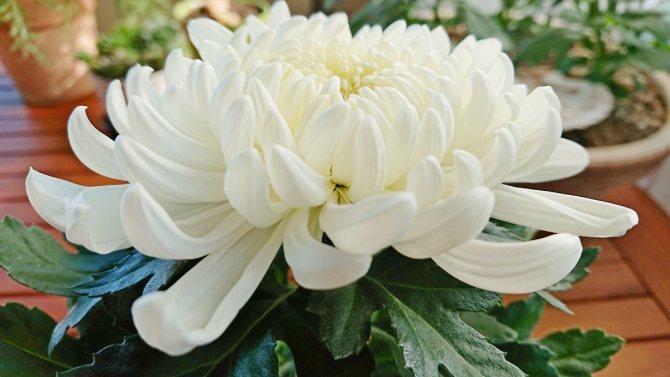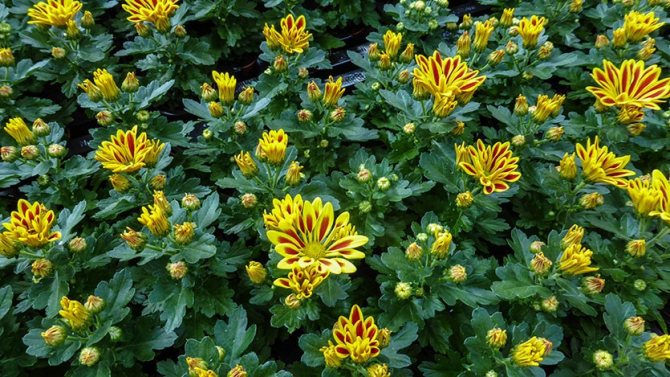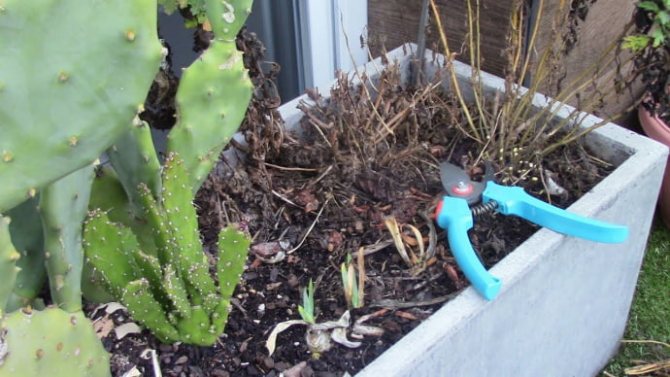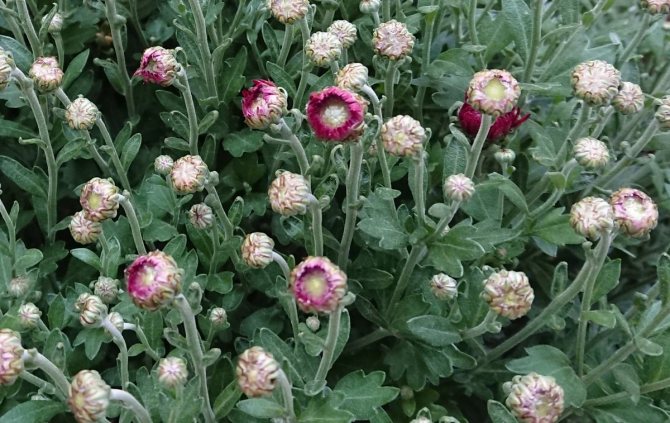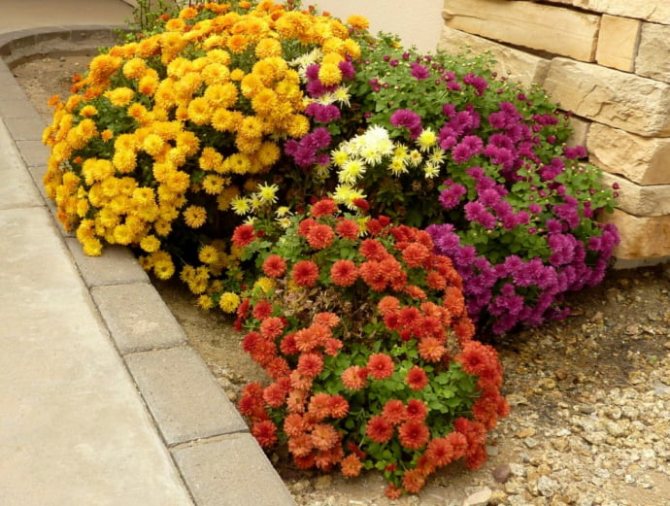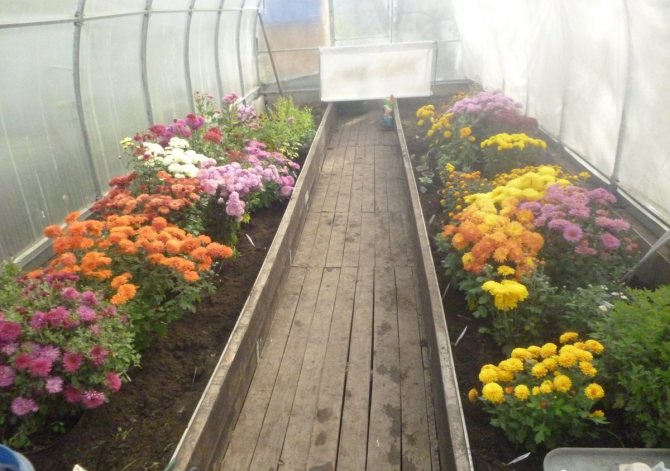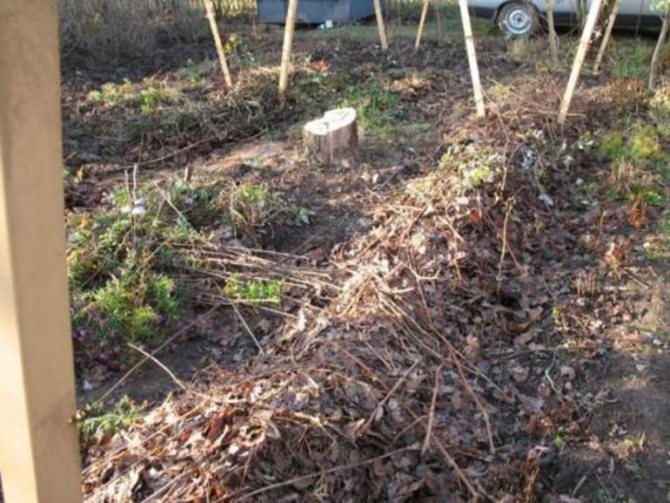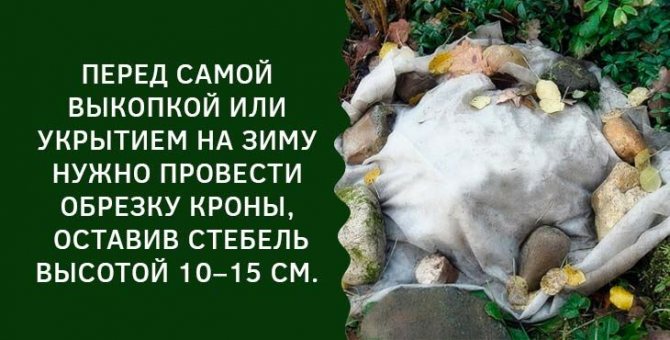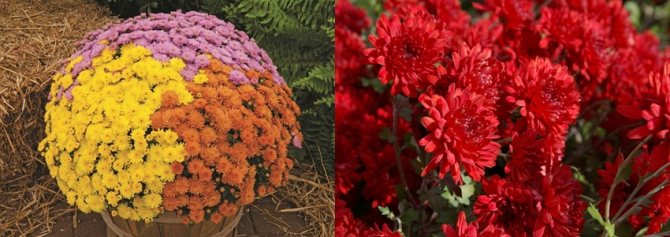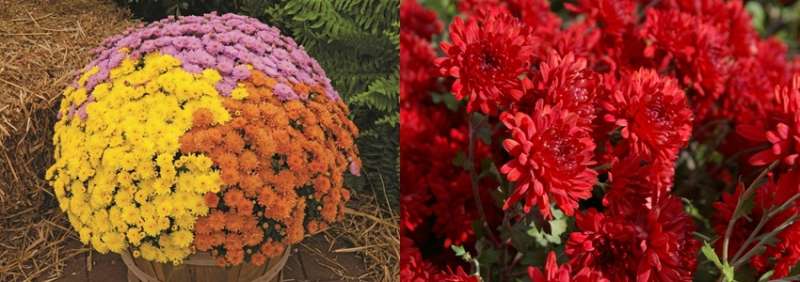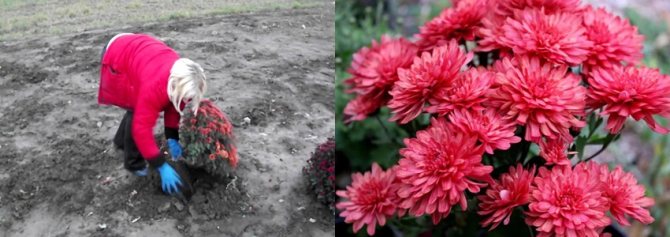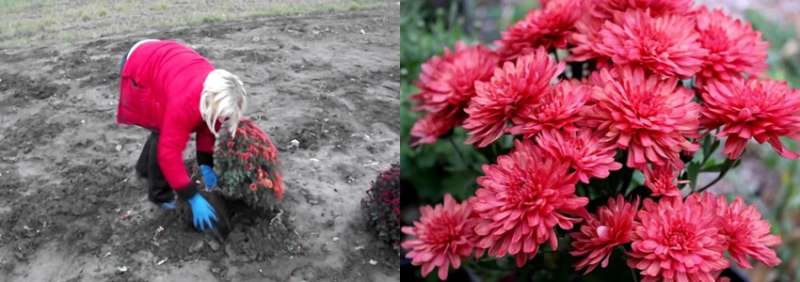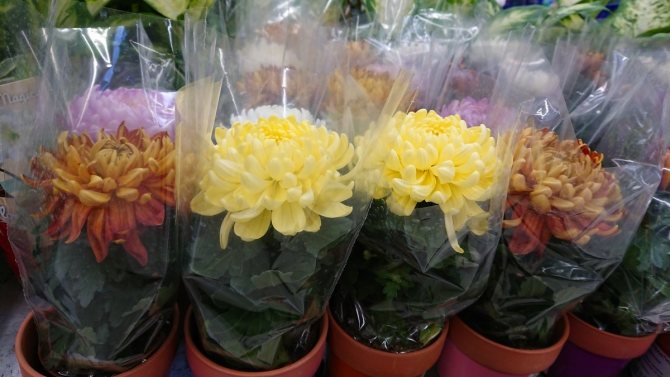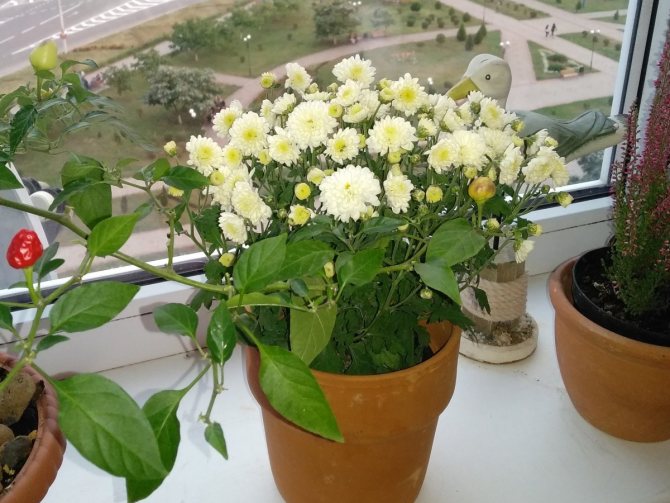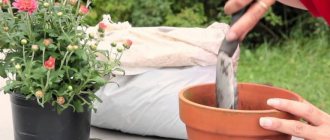Most chrysanthemums are perennial flowers by nature, but those plants that do not remain in the open field in winter require special storage conditions. In winter, chrysanthemums definitely need rest, growth processes are slowed down due to storage at a low temperature. There are several ways to store chrysanthemums in winter (this also applies to roses), and each summer resident can choose a suitable option, focusing on their own capabilities and varietal characteristics of pets.
The main condition for successful storage is the creation of a low positive temperature for any perennial chrysanthemums in winter (run-up from 1 to 5 degrees of heat) with moderate humidity.
Preparing plants for wintering
The preparation of plants for wintering in each region begins in different ways. In the Moscow region, such work begins at the end of August. In the southern regions, they begin to worry about sheltering heat-loving plants in early or mid-autumn. At this time, gardeners cut off the stems, apply fertilizer to the soil and begin a winter shelter.
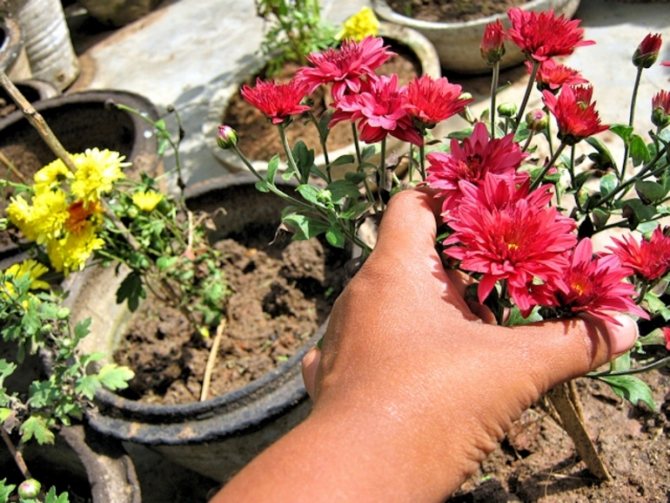
Fact!
Some varieties of chrysanthemums must be dug up for the winter and stored in a basement or other cool place, while others can be left in the ground for the entire cold period.
At the end of the summer season, fertilizer should be applied under the bush. The recommended composition of the dressing is a complex one with a higher amount of phosphorus and a lower concentration of potassium. Such an agronomic operation will provide the plant's root system with adequate nutrition and increase its cold resistance.
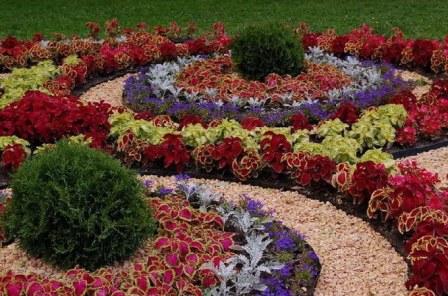

You may be interested in:
Flowerbeds blooming all summer A flower bed is a garden flower bed, raised above the lawn or paths, decorated in the form of a closed figure. And everyone ... Read more ...
Chrysanthemums in the greenhouse
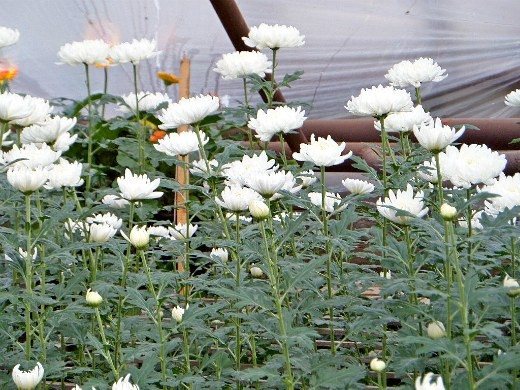

If a gardener at his summer cottage has a winter greenhouse, loggia, veranda or other room in which a stable temperature can be maintained in winter from zero to plus five degrees, then it is most convenient to store any chrysanthemums there. Falling asleep, pruned plants are placed in pots or (if it is a greenhouse) the root system and containers are added. The soil should be very loose and water-permeable, it is kept in a slightly moist state. At the beginning of the new season, the temperature and watering are increased, motivating the awakening of the seedlings. This method is used to preserve, as a rule, large-flowered, late blooming varieties, as well as plants for commercial purposes (early sale of seedlings, sale of potted flowers and bouquets).
Autumn pruning


All plants (wintering in the ground and dug out) are subject to autumn pruning. The procedure is started after a seasonal drop in temperature. You should not be too zealous and cut off the shoots at the root. Above the ground stems must remain at least 10 cm in length.
Florists are not unanimous in the opinion whether it is necessary to dig up all the chrysanthemums for the winter. Some believe that all plants should be dug up due to the fact that they can suffer from both frost and prolonged thaw. Others prefer to rely on the climatic conditions of the region in which the plants are grown.


You may be interested in:
Perennial flowers for a flower bed, blooming all summer: undersized Along with annual flowers in a flower bed, summer residents always try to plant perennial flowers, and sometimes only ... Read more ...
Do I need to repot my potted chrysanthemum after purchase?
Store-bought chrysanthemums always have a good supply of long-lasting fertilizers in a small pot. It will definitely last until the summer. But the pot is small and should be replaced with a slightly larger one with the addition of new soil. I add garden soil with some river sand and wood ash. It is important not to bring the larvae of the beetle with the ground!
You can use ready-made, slightly acidic or neutral peat soil with the addition of perlite, sometimes it is advised to take a slightly alkaline soil - experts do not have a consensus on this issue.
When a chrysanthemum is taken out of a purchased pot, it is sometimes found that it is not one plant, but three or four. Such lush "bouquets" will bloom longer in a pot than cut flowers, but like perennials, these chrysanthemums are unlikely to survive if left together. Chrysanthemums do not like thickened plantings even in the garden, not to mention pots. In this case, either the excess plants are cut off, leaving one more powerful chrysanthemum, or they are separated and planted in separate pots.
But if you bought chrysanthemums that are just going to bloom and they do not have a single opened flower, then you should wait with a transplant. At the budding stage, chrysanthemums are very vulnerable. And as soon as the first flowers open, the plants can be safely replanted.
What varieties should be dug
Chrysanthemums "Multiflora", large-flowered and branch varieties are subject to obligatory extraction from the soil. It has been noticed that plants with large inflorescences do not tolerate well overwintering in the ground. They are removed from the ground after the onset of cold weather and sent to storage in a dry basement.
Indian varieties are especially in need of gentle wintering:
- Golden Orpheus;
- Helen, etc.
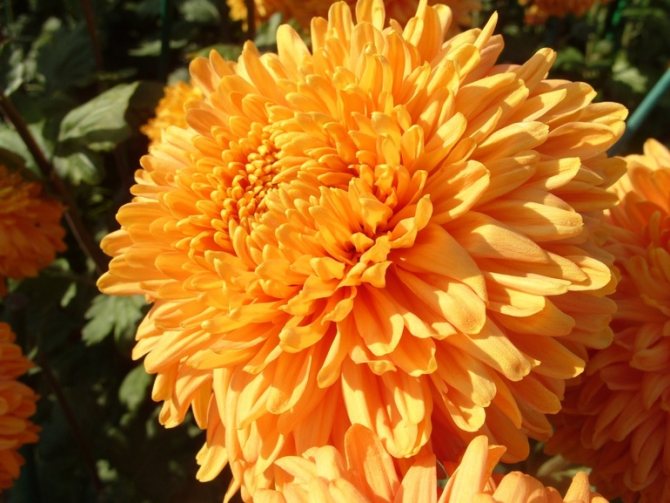

Similar plants can be transplanted into greenhouses, insulated loggias or greenhouses.
Helpful!
In those regions where there is a short season with a positive temperature, it is recommended to grow chrysanthemums for cutting in heated greenhouses. If chrysanthemums are grown for decorative purposes, you should pay attention to Korean varieties with small inflorescences.
Popular varieties of small-flowered chrysanthemums are:
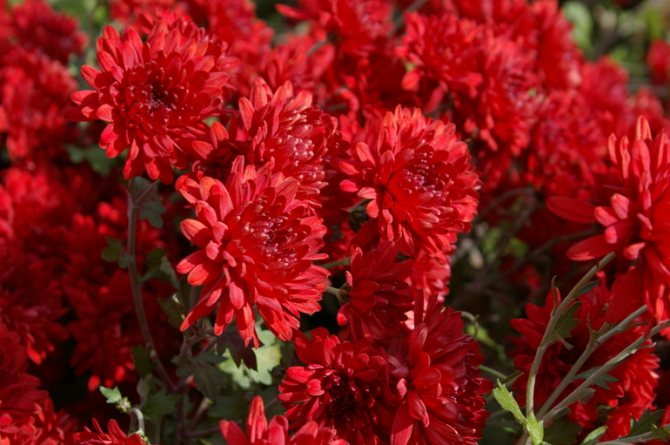

- Oak;
- Red Moscow;
- Purple Haze;
- Everest;
- Korean;
- Malchish-Kibalchish;
- Chamomile, etc.
In all regions with a warm climate, they can be left for the winter in the ground, having previously taken care of the shelter without the risk of freezing.
You may be interested in:
About the dates of digging tulips after flowering Tulip gardeners know how important it is to dig the bulb correctly and preserve ... Read more ...
You need to come to the right decision, dig up or leave chrysanthemums in the ground after reading the useful information. The climatic conditions of the region should be taken into account. It is known that under a layer of snow all plants survive perfectly even in severe winters. But if the cold season passes without snow and with severe frosts, then chrysanthemums from such conditions may not withstand and die. The same damage to the roots will be caused by the frequent alternation of thaw and frost, prolonged precipitation in the form of rain.
The second important factor to consider is the chrysanthemum variety. For the middle lane and the Moscow region, Korean hybrid varieties are preferred. When purchasing a plant you like, it is important not to make a mistake and buy a garden flower, not an indoor flower.
Advice!
Planting and caring for chrysanthemums is essential. From a well-chosen place in the garden, it will depend on whether the root system will dry out during prolonged thaws.
The planting of newly acquired bushes should be started no later than the end of August in order to give time for the chrysanthemum to fully root. Phosphorus fertilizers are added to the planting pit, and the plant will need nitrogen fertilizers in the spring. Potash fertilizers are used during the warm season for abundant flowering.
Digging and transplanting
Chrysanthemums can be dug up in the fall. But only when the temperature does not rise above zero. Fundamental rules:
- Before digging, the bush should be moistened with water, so the roots will be less susceptible to damage.
- Dig it out carefully so as not to damage the roots. This can be done with a pitchfork, retreating from the stalk by 15 cm.
- Taking out the plant, the earthen lump is not destroyed.
- If the roots are nevertheless damaged or pests are noticed on them, the affected part is cut off and treated with appropriate means.
- The bush is placed in a container that is suitable in size, the earth is poured so that it fills all the voids and is slightly moistened.
You can store the plant in a cellar or basement, in any other room, where the temperature is about + 5 ° C.
With the appearance of heat, it will be possible to take it out to the greenhouse or put it in the room.
Large-flowered and globular varieties require excavation.
Caring for dwarf varieties
Compared to traditional varieties of chrysanthemums, their dwarf congregation has been recently bred. Their mission is to decorate balconies, loggias, mixborders and even apartments. Residents of the southern regions are not too concerned about shelter for the winter of globular varieties of these plants. It is enough to cover them with spruce branches - and the shelter is ready.
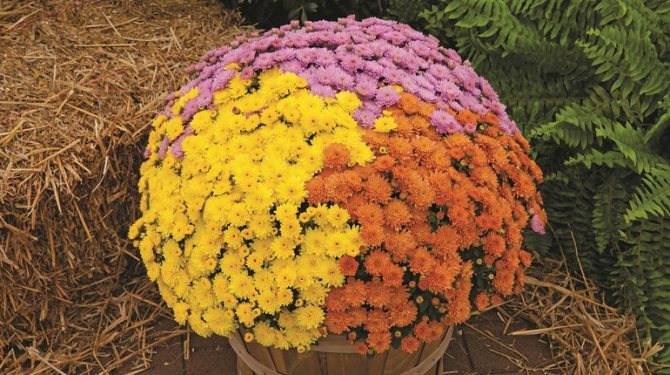

In a harsh climate such chrysanthemums must be dug up... Rhizomes should be removed from the soil after the ground part has dried. After light cleansing of the soil, the roots of the chrysanthemums are laid out in the shade to dry out. After removing dead fragments, the roots are placed in containers with sawdust or straw and sent to a dry basement.
Some growers do it differently. Immediately after removing the plant from the soil, cut off the shoots, having previously left 10 cm of the stem, and place the rhizome in a flower pot with peat. A drainage layer of foam fragments is laid out on the bottom of the container. It is recommended to moisten the roots, and treat the stems with an insecticide. This measure will allow in the coming season to protect the plant from aphids and other pests. This is how chrysanthemums are stored in the basement in winter until spring.
In most cases, dwarf chrysanthemums are grown indoors. But the southern regions allow them to be planted in flower beds and not taken out for the winter. When dwarf plants are kept indoors, the ground part is cut off in autumn, the length of the remaining shoots is only 10 cm. The container is transferred to a dry room with an ambient temperature of +8 ° C. It is worth moisturizing the plants no more than 1 time per month. Do not forget to sign the variety name on the containers.
Biological features of chrysanthemums
More than 20 species of chrysanthemums are known in culture (not counting varieties and hybrids), but all of them are plants of short daylight hours, that is, they enter the flowering phase when the duration of the daylight period is reduced to 9-10 hours. By and large, they can bloom in pots in early spring - a good gift for March 8, isn't it?
For the normal development of plants, a certain temperature regime is required: in the summer - 20-23 ° C, in the fall - 15-18 C, in winter (dormant period) - 3-8 ° C.
Chrysanthemums are moisture-loving, but they do not tolerate waterlogging of the soil, so they need to be watered as the top layer of the soil substrate dries up. Plants are demanding on air humidity - this criterion should be paid special attention to if you intend to keep your pets in pots in winter.
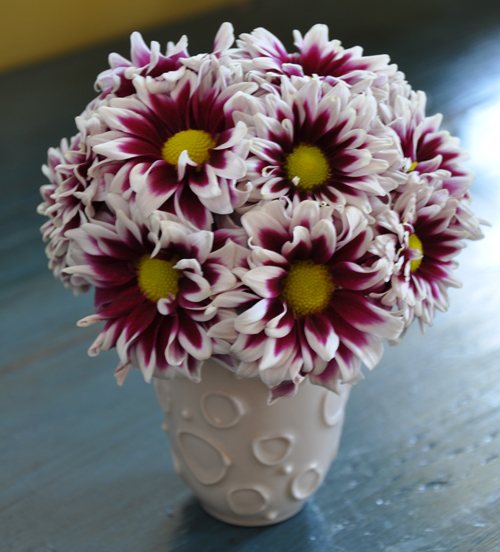

Shelter organization
Plants should be covered in stages. Initially, pruning is performed, and then hilling is done.When hilling, the presence of pits and grooves should be excluded, in which excess moisture can subsequently accumulate.
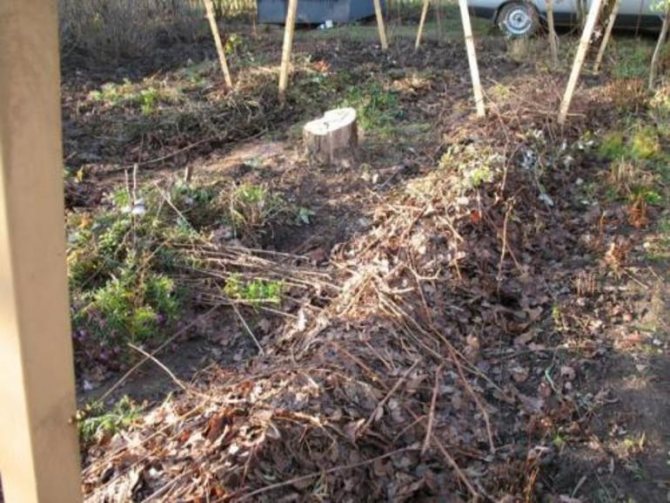

Florists should huddle bushes in the ground so that they are completely covered. In harsh climatic conditions, it is additionally recommended to cover the chrysanthemum bushes with spruce branches or sawdust. But it is worth starting the second protective layer after the established frosty weather.
Bricks, slate sheets or other available material are used as shelter for wintering plant bushes. Around the rhizome, protective walls are laid out of bricks and covered with a sheet of slate on top. Shelters are built from special agrotechnical or improvised material. Breathable agronomic lutrasil or spandbond can be used as a roof. With this design, ventilation and protection from heavy rainfall will be provided.
You almost always need to cover chrysanthemums for the winter, but not too warm. A big mistake of florists is an unnecessarily large layer of shelter, under which the plant grows out. Those who do not want to risk rare varieties, a small fragment of the root is separated from the mother plant and stored in the basement. The main plant is covered and left to winter in the ground.
The simplified shelter procedure is as follows:


- The ground part of the chrysanthemum is cut off, 15-20 cm shoots remain.
- The bush is covered with soil or peat.
- A layer of foliage and spruce branches is laid.
In addition to the mulching method, you can save chrysanthemums without digging out in winter using another method - planting in a trench. To implement this method of wintering, it is necessary to build a depression up to 50 cm high. The deepening is created on a hill, and its bottom is insulated with needles or spruce branches. Chrysanthemum roots are placed tightly together and lightly sprinkled with peat. Then the plants are covered in layers with polyethylene, boards and slate sheets.
Not everyone has the opportunity to keep plants in a dark room. Flower growers, deprived of utility rooms, have to set them aside on the street. In order for the wintering of chrysanthemums in the open field to pass without problems, you need to heed the practical advice of experts.
Water-charging chrysanthemums
There is an opinion, and it is really correct, that chrysanthemums in winter die not at all because of the cold, but because of a lack of moisture.
In the fall, it is simply necessary to carry out water-charging irrigation, with the expectation of 5 liters of water per bush. Then the soil should be well loosened and covered with mulch, it will not allow moisture to evaporate. The soil will be enriched with oxygen.
Recent Entries
Gardener's lunar calendar for 2020: we do it right 3 reasons, make a reservoir in the country: we plan a new season Note for gardeners: 7 useful things to save energy
There is one more small nuance, if autumn is dry, and rains are rare, you need to take more water for irrigation. But in such a choice you need to be very careful.
Chrysanthemum storage in winter
In the trench
The optimum depth of the ditch is within half a meter. But the place should be chosen on a hill, otherwise the melt water will flood the chrysanthemum and it will rot before it can be planted on the territory. The bottom of the ditch and the walls must be insulated (for example, with expanded clay and boards). Flowers are dug up together with clods of earth and tightly packed into the trench. From above, it is covered so as to prevent moisture and cold from getting inside. Actually, everything that is at hand will be used - pieces of slate, roofing material, film and so on.
This method of shelter is convenient because the chrysanthemum is in its natural environment. Therefore, it blooms after planting in the place in early spring.
In the cellar on the floor
The root system of the bushes, which are dug up and carried with the remnants of the soil, is covered with material (or placed in linen bags).If the floor is earthen in the cellar, this is quite enough for the chrysanthemum to be comfortable during the entire cold period. Depending on the microclimate in such a confined space, the fabric can be moistened periodically. The main thing is to prevent root rotting.


In a container
As such, boxes, buckets are used, that is, everything where you can put the chrysanthemum and load the soil mixture from above. It's easy to find a place for them for the winter - a basement, a shed, a heated balcony, the same cellar (on a rack). The temperature should not go beyond 0 - 5 ° C (naturally, with a plus sign). The prepared soil is poured into the selected container. Its most common recipe is peat + coarse sand (in equal proportions).
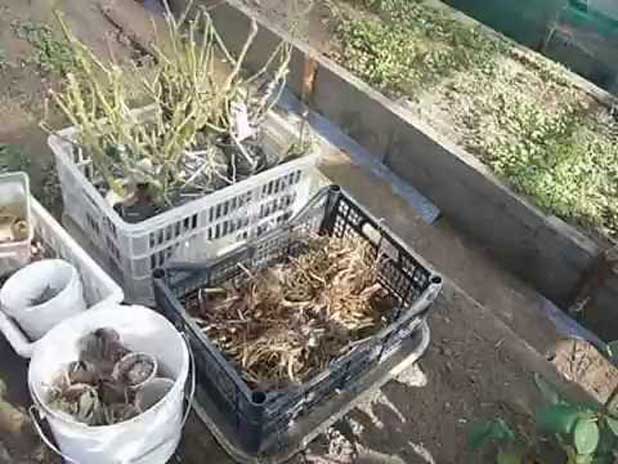

Useful Tips
- There is no single recommendation for the start time of work related to the shelter of the chrysanthemum. It is necessary to be guided by the weather. "Signal" - the first frost. Experienced flower growers advise to wait a few days for the flowers to undergo a little hardening. This will allow them to better survive the winter, regardless of the chosen method of saving in the cold season. That is, pruning of bushes and all other activities are carried out approximately on the third or fourth day.
- You should not use plant debris, weeds, branches, straw for the winter shelter of chrysanthemums, although there are also such recommendations. It is not for nothing that everything that is collected on the site is disposed of in the oven. It is in the fallen leaves, cut dried shoots that garden pests like to settle. If all this is put on a chrysanthemum, then it is unlikely that she will meet the spring unaffected.
- In the process of storing chrysanthemums, the main thing is the stability of the microclimate. Sudden jumps in humidity or temperature can destroy the flower, and it will not survive the winter.
It turns out that there is nothing difficult in preparing a chrysanthemum for winter. If you take care of the plant during the season, then in the fall it will only be necessary to cover it or move it from the site to another place.
What materials are used for shelter
The main materials for sheltering plants for the winter are: coniferous spruce branches, fallen leaves, coniferous litter, sawdust, burlap, agrofibre, peat, humus, expanded clay, fern, foliage, etc.
Snow has always been considered a natural covering material. But in recent years, we rarely have truly snowy winters, thaws and winds often occur. Autumn leaves are an excellent covering material. You can collect them in the forest or parks. Just remember that the leaves must certainly be dry.
Spruce branches are very popular among summer residents as a covering material. Lapnik excludes direct contact of the plant with wet snow and ice crust. And also spruce branches will protect the plant from overheating by direct sunlight in early spring and ensure good ventilation of the plant.
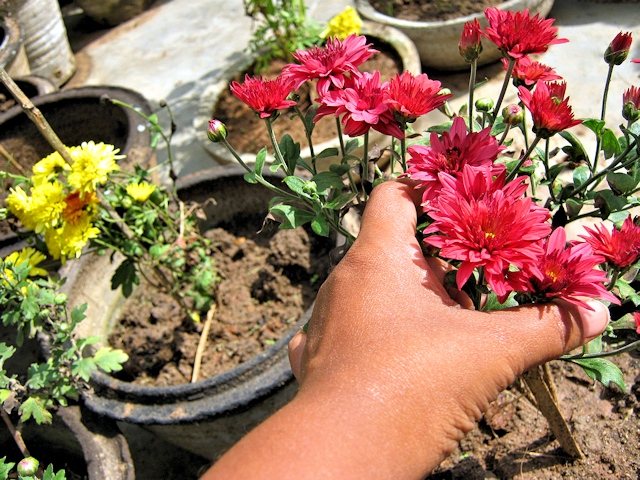

You can cover plants with expanded clay, which is also an excellent mulch, drainage and heat insulator. Moreover, the advantage of expanded clay lies in the fact that it protects plants, both in winter and in summer, perfectly protecting them from decay of the root system.
As for peat, it should be remembered that it strongly acidifies the soil. Therefore, when warming plants with peat, you need to know for which plants it can be used.
Modern synthetic non-woven covering materials are widely used to shelter plants for the winter. These are agrofibre, spunbond, agrotex, lutrasil, burlap, jute, various types of film, etc. The main and most acceptable methods of winter shelters using artificial materials are: free swaddling; use of ready-made covers.
Read more: Outdoor tomato care
Autumn pruning and fertilization
In late summer - early autumn (August-September), complex fertilizers containing potassium (less) and phosphorus (more) are applied under each chrysanthemum bush.These elements are necessary for flowers in order for their root system to accumulate the nutrients it needs for normal wintering.
Pruning chrysanthemums in autumn is a necessary procedure that makes it easier for flower growers to shelter for the winter those varieties that winter outdoors. And those flowers that are removed to the basement for the winter should also be cut off - this way they are easier to store, long stems can be accidentally broken off.


Chrysanthemum stems are pruned immediately after the onset of the first autumn cold weather. In this case, the length of the cut off shoots should not exceed 14-15 cm.
Greenhouse conditions
A greenhouse can also act as a storage room for plants, where they are transplanted since autumn. And there will be no problems with transplant tolerance. When the temperature drops, the stems freeze and need pruning. The branches are completely removed, leaving hemp with a height of 2 to 3 centimeters. A good insulation will be peat or humus, poured on top with a thick layer.
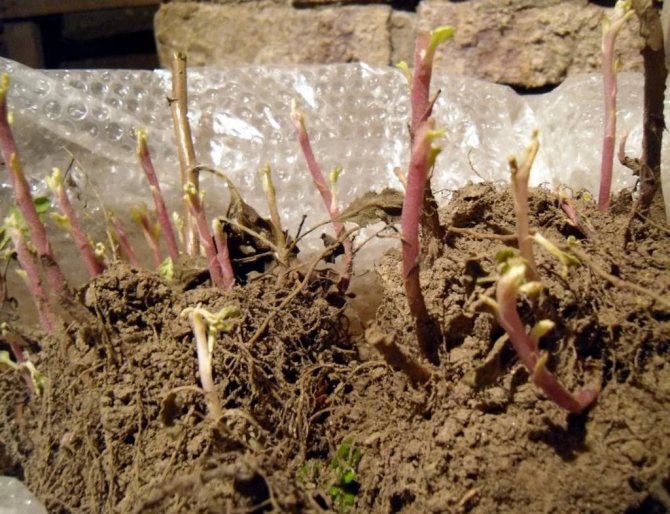

An even better insulation for chrysanthemums in the greenhouse will be dry earth, which is covered with each bush at a height of 20 to 25 centimeters. Moisture for bushes can become dangerous, so you need to make sure that the soil is exactly dry. If you notice signs of dampness, look at the bushes for the appearance of fungal diseases and mold. After sprinkling with earth, cover the top with covering material in 3 or 4 layers.
Maintenance and care of indoor flowers
In the spring, it is imperative to open the bushes on time. To avoid damping, which can be even more dangerous than hard frosts. In the spring, at stable above-zero temperatures, the plants must be dug up, brought into the sun to warm up for a couple of days. After that, you can start watering. And after 2-3 weeks they can be transferred for planting in open ground. If there is heating with a temperature regime from 0 to + 5 degrees, you do not need to cover the flowers, they will be preserved perfectly.
How to prepare chrysanthemums for winter in Siberia, so as not to freeze
In the harsh conditions of Siberia, it is necessary to prepare additional measures to protect the culture from frost. For this, fences are being built. An important condition is that these shelters should not fit snugly against the bush and block the free access of air.


What can be used for fences:
- Boards, boxes;
- Bricks, stone;
- Slate, metal tiles;
- Covering material.
These materials are used to build a "house" or frame ABOVE the bush, at a short distance from the ground. But this is not enough. When the first snow falls, it is worth throwing it over and around the shelter.
You can dig up one bush of each variety to insure if the bushes do freeze.
general description
Chrysanthemums belong to the Astrov family, a class of dicotyledons, characterized by the duration and abundance of flowering. According to the type of flowering, they are of 3 types.
- Small-flowered, or Korean, culture reaches 30 cm, flower from 3 to 5 cm in diameter.
- Decorative, have medium flowers up to 10 cm in diameter, reach 70 cm in height.
- Large-flowered chrysanthemums grow up to 120 cm, have flowers up to 30 cm in diameter.
Depending on the variety, chrysanthemums are annual and perennial, they have different colors: yellow, red, purple, blue.
Plants are distinguished according to growing conditions:
- in the open field;
- at home.
Treatment against pests and diseases
If the plants have been infested with insects, they must be treated with insecticides. Then you can transfer the plants to the basements. Rhizomes can be placed on the basement floor or in boxes with earth, covered with a layer of soil 5-7 cm. The bushes are placed tightly. On top they are sprinkled with a substrate. Thus, the roots will constantly have access to moisture.
If the room is warm, the chrysanthemum may wake up and start growing in the middle of winter. This should not be the case, since the shoots will weaken and become very thin. It is advisable to place a thermometer in the room to control the temperature.
No other additional plant care activities are foreseen in winter. You just need to inspect them at least once every month. If sluggish or dried roots catch your eye, it means that they lack moisture. You need to spray the root system with water. If mold has become noticeable on the roots, the plants should be removed from the basement, and the remaining bushes should be treated with antifungal agents. Basement storage is one of the most affordable traditional methods.
10-12 days after the autumn fertilization, it's time to treat the flowers from pests and pathogens. Chrysanthemums are susceptible to fusarium, rust, and other fungal diseases, as well as aphids and spider mites parasitize them.
On a quiet and warm day, the plants are abundantly sprayed:
- Bordeaux mixture (you can buy a ready-made composition in a garden store);
- foundation (20 g per 10 liters of water).
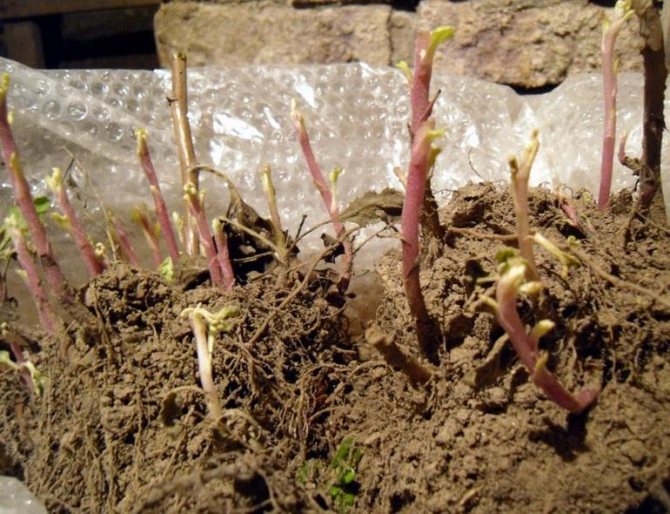

For aphids and spider mites, insecticides (Aktellik, Inta Vir), karbofos, makhorka (100 g per 1 liter of water) are used.
They process not only the stems and leaves, but also the soil around the bushes. All plants, even healthy-looking ones, are sprayed.
Tips from experienced florists
Chrysanthemum is a flower that not everyone can grow. Therefore, not everyone decides to land it. In order for the plant to please the eye for many years, you should take into account the advice of experienced florists:
- Flowers should be transplanted only in cloudy weather without the sun. Better if there is no wind. If the procedure is carried out on a sunny hot day, the plant will experience stress and will not tolerate a transplant.
- For chrysanthemums with large flowers, stepchildren must be cut off (like tomatoes).
- You should not keep the flower in one place for more than 3 years in a row, otherwise the plant will suffer from diseases and pests, and the flowers will gradually become smaller and smaller.
- When planting, a mixture of peat, manure and river sand is added to the ground to enrich the soil with nutrients.
The development of plants largely depends on what kind of planting material was purchased. Chrysanthemum cuttings should be healthy and strong, with no visible signs of fungus or pests.
To make the flowers look spectacular on the site, it is recommended to plant them next to perennial asters. Chrysanthemums located next to the hedge look beautiful. It is better to cut flowers planted in a group at the same time so that all bushes have approximately the same shape. Then they will look especially picturesque. It is better to choose varieties with large flowers that are clearly visible from a distance. If the gardener noticed that the size of the inflorescences is decreasing every year, the plant needs to be urgently transplanted to a new place. After some time, the chrysanthemum will again be covered with large, beautiful flowers.
Garden chrysanthemum is one of the most beautiful and popular flowers. Proper care will help to successfully solve all the problems that arise when growing this plant. A properly cared-for bush will grace a street park. Also, chrysanthemum is guaranteed to be the center of attention in any garden area.
Preservation by cuttings
If the chrysanthemums were purchased in late autumn and there is no way to arrange them for the winter in a suitable room, then you can leave the flowers in the apartment. However, there is no guarantee of their safety until spring (even with backlighting), so cuttings are used. Plants in pots are located on the windowsill closer to the window, away from the heating. Several cuttings (3-4 cm long) are plucked from the leaf sinuses. For their rooting, small cups filled with nutritious soil are prepared.
The planting technique is simple: a depression is made in the middle of the container, sand is poured into it, moistened, then the cutting is immersed (about 1 cm). The glass is tied with a plastic bag, but loosely so that ventilation remains.In such a greenhouse, a chrysanthemum stalk usually "sits" for 1-2 months, and then starts to grow. As soon as the roots become visible through the walls of the container or the first leaves appear, the shelter is removed. Buds may form, but they are removed immediately. Healthy planting material will be ready by spring.
Chrysanthemums amaze with their varietal variety, brightness, original forms. But many are afraid to grow them precisely because of the risk of freezing. Fortunately, keeping chrysanthemum bushes until next season is not difficult, even if there is no suitable space.
How to care in winter
- To continue flowering, many advise the use of growth stimulants and biostimulants, which include drugs such as Zircon and Bud.
- Periodically, it is necessary to inspect the dense crown of the plant and remove dried yellowed leaves at the bottom of the shoots. It is there that pest larvae and pathogenic bacteria most often accumulate. It is also necessary to remove all faded buds. Then the flowering period will last for a longer period.
- If you left the plant outside, be sure to tie it up so that strong wind or rain does not break the bush.
- Pinch the tops of the shoots so that the bushes don't grow too much.
- Important: when watering, try not to get water on the leaf plates of the plant. Otherwise, infections or fungal diseases may start there.
Reasons for the lack of flowering chrysanthemums in the fall
Sometimes it happens that for some reason the plant does not begin to bloom in due time. What are the reasons for the lack of bud formation? There may be several of them.
- One of the main reasons may be a lack of light or an excess of it. If the daylight hours are less than 7 hours, then the flowering period may not wait. Try adding fluorescent light to the plant.
- If it's too late pruning or pinching the twigs.
- Poor soil composition, deficiency of potassium and phosphorus, which contribute to abundant and prolonged flowering.
- When the chrysanthemum is tall and bushy, it is a mistake to overfeed it with nitrogen-containing fertilizers. As a result, the green mass builds up, but flowering does not occur. It is necessary to fertilize with potassium - phosphorus fertilizers with a low nitrogen content.
- When the room temperature is more than 20 - 25 degrees, the chrysanthemum may refuse to bloom.


